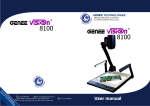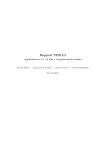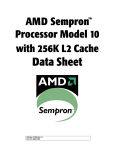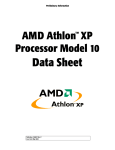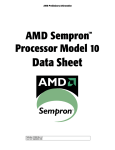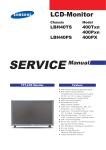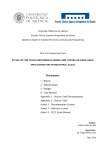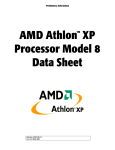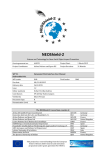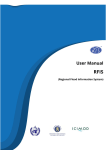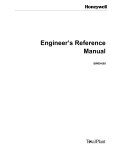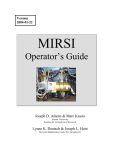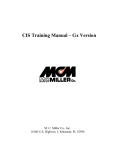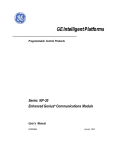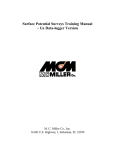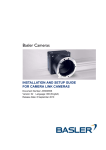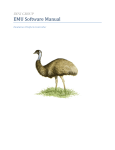Download User Manual
Transcript
Software Diagnostics Developer Edition 1.0 © 201 0 Software Diagnostics SD Developer Edition User Guide for Software Diagnostics Developer Edition 1.0 by Software Diagnostics This document describes the features of SD Dev Edition and prov ides quickstart tutorials to enable y ou to apply the tool right away . Throughout the manual, the abbrev iation SD Dev Edition is used to refer to Software Diagnostics Dev eloper Edition. Thank y ou for using Software Diagnostics Dev eloper Edition. SD Developer Edition © 201 0 Software Diagnostics All rights reserv ed. No parts of this work may be reproduced in any form or by any means graphic, electronic, or mechanical, including photocopy ing, recording, taping, or information storage and retriev al sy stems - without the written permission of the publisher. Products that are referred to in this document may be either trademarks and/or registered trademarks of the respectiv e owners. The publisher and the author make no claim to these trademarks. While ev ery precaution has been taken in the preparation of this document, the publisher and the author assume no responsibility for errors or omissions, or for damages resulting from the use of information contained in this document or from the use of programs and source code that may accompany it. In no ev ent shall the publisher and the author be liable for any loss of profit or any other commercial damage caused or alleged to hav e been caused directly or indirectly by this document. Author and Company Informations: Software Diagnostics August Bebel Straße 26-53 D-1 4482 Potsdam Germany CEO: Marc Hildebrandt Johannes Bohnet Amtsgericht Potsdam HRB 221 23 P Finanzamt Potsdam Stadt Phone: +49 331 7 062340 Fax : +49 331 7 062341 EMail: [email protected] Internet: http://www.softwarediagnostics.com Printed: Mai 201 0 in Potsdam, Germany V ersion: SD Dev eloper Edition 1 .0.5400 4 SD Dev eloper Edition Table of Contents 7 Part I Quickstart 1.1 Tracing Methods 7 1.2 Tracing Strategies 8 Part II Operational Requirements and Installation 10 2.1 Operational Requirements 10 2.2 Installation 10 Part III Prepare Your Software System 3.1 Initial Preparation Part IV Trace Your System's Behavior 12 12 15 4.1 Optional Preparation Step 15 4.2 Start Tracing 15 4.2.1 TraceOv er 15 4.2.2 AttachToProcess 18 4.2.3 StartWithTracing 18 4.3 SD Recorder 19 4.4 Polluting Functions 20 4.5 Probes 21 4.5.1 DataProbes 21 4.5.2 MemAccessProbes (ex perimental) 24 4.5.3 ParamProbes 25 Part V Import Traces 28 5.1 Create Project Dialog 28 5.2 Import Dialog 28 5.3 Manage and Delete Traces 29 Part VI Visual Analysis 32 6.1 CallStackView 32 6.2 CallGraphView 34 6.3 SingleCallView 34 6.4 SearchView 35 Part VII Tutorials 37 7.1 Bug: Erroneous Database Entry 37 7.2 Bug: XML Content Written in Wrong Order 39 7.3 Feature Location: Privacy Data in Google Chrome 43 © 2010 Softw are Diagnos tics Ex perimental Features Part VIII Experimental Features Part IX Problems and Known Issues © 2010 Softw are Diagnos tics 5 47 49 Part I Quickstart Quickstart 1 7 Quickstart This chapter briefly describes the m ost im portant steps for using SD Dev Edition. 1.1 Tracing Methods There are three different way s to trace y our application. All three m ethods are started by clicking the Tracing icon in the Visual Studio toolbar. The m ethods av ailable are dependent on the state of the Visual Studio debugger. (1 ) StartWithTracing You hav en't started y our app y et. Click the Tracing icon. Click Start Debugger. The app starts in tracing m ode. Record a trace with the SD Recorder. You alway s should start tracing with a low polluting functions threshold, e.g., 1 0. (2 ) AttachToProcess Your app is running, howev er, not under control of the Visual Studio debugger. For instance, y ou hav e started it with Visual Studio's Ctrl-F5 StartWithoutDebugging. Click Tracing icon. Choose the process ID of y our app. Click AttachToProcess. With the SD Recorder y ou record a trace. You alway s should start tracing with a sm all polluting functions threshold, e.g., 1 0. (3 ) TraceOv er Your app is currently debugged by the Visual Studio debugger and it is in break m ode. You © 2010 Softw are Diagnos tics 8 SD Dev eloper Edition are probably perform ing StepInto and StepOv er operations to nav igate through the execution. If y ou are at a point in the execution where y ou are not sure if StepInto is a waste of tim e or if StepOv er skips an im portant part of the execution, then use TraceOv er. Click the Tracing icon. Choose the point in the code where tracing should be stopped by clicking the m ore and less buttons. Choose one of the TraceOv er options. Be sure that the control flow passes the code line where the blue region ends. If the control flow m isses this point in the code, TraceOv er won't stop. You m ay be concerned when TraceOv er takes a long tim e and nothing happens. In this case, use the Stop icon in the Visual Studio toolbar to interrupt tracing. - Prepare Your Software Sy stem After preparing y our software sy stem , y ou should at least exclude com pilergenerated functions and functions of the Standard Tem plate Library STL from being traced. Otherwise, y ou get huge traces with lots of inform ation on com piler and STL internals. For details read the respectiv e chapter. 1.2 Tracing Strategies The m ain strategy is to identify the core part of execution that is of interest for y our current task. Hence, the goal is to do a TraceOv er of a reasonably sm all num ber of function calls, e.g., 1 0.000, and trace them with full detail, e.g., with detailed Param Probes. - Find a good place for a breakpoint Start y our app without Visual Studio debugging support (Ctrl-F5). Do the necessary interactions with y our app. Do AttachToProcess. Choose a low polluting functions threshold, e.g., 1 0. Click Record in SD Recorder. Interact with y our app. Click Stop. Analy ze the trace. Identify the interesting part of execution, i.e., the responsible call that triggers this part of the execution. Switch to Visual Studio's code v iew v ia the context m enu of the call and place a breakpoint. Click the (Software Diagnostics) Stop icon in the Visual Studio toolbar and switch the process to the Visual Studio debugger. Click run in Visual Studio and interact with y our app such that the control flow hits the breakpoint. Do TraceOv er. If y ou don't know how m any calls are triggered by TraceOv er try a polluting functions threshold of 50-1 00 and do not use Param Probes. (With Param Probes the polluting functions m echanism won't find m any of these functions.) Analy ze the trace and find an ev en m ore detailed part of the execution that is of interest. Do TraceOv er again. If y ou are sure that y ou trace less than 1 0.000 calls, use DetailedParam Probes to record not only the calls but also all param eter v alues that are passed into the functions. Analy ze the trace. The search v iew also searches Param Probes which lets y ou search for suspicious param eter v alues. © 2010 Softw are Diagnos tics Part II Operational Requirements and Installation 10 2 SD Dev eloper Edition Operational Requirements and Installation This chapter outlines the operational requirem ents of SD Dev Edition and guides y ou through the installation process. 2.1 Operational Requirements SD Dev Edition depends on software packages of other v endors. You need to hav e installed at least: Microsoft Windows XP, Microsoft Windows Vista or Microsoft Windows 7 Microsoft Visual Studio 2 008 x86 com patible env ironm ent (on x6 4 it runs as an x86 application) .NET Fram ework 3 .5 (latest updates) Microsoft Debugging Tools for Windows x86 (tested with 6 .1 1 .1 .4 04 ) SD Dev Edition requires m inim al hardware support: Graphics Card with OpenGL 1 .4 support 2.2 Installation If y ou hav e a prev ious v ersion of SD Dev Edition, please uninstall this v ersion first before installing the new v ersion. The uninstall executable is found in the start m enu. To install SD Dev Edition, run the installer executable. The following com ponents are installed: SD Dev Edition: the m ain application is installed to "Program Files/Software Diagnostics/ Dev eloper Edition" ("Program Files (x86 )/Software Diagnostics/Dev eloper Edition" on x6 4 operating sy stem s) [env ironm ent v ariable SD_HOME] sd_v saddin_2 008.dll: is the Microsoft Visual Studio addin com ponent of SD Dev Edition and is placed in "My Docum ents/Visual Studio 2 008/Addins/". SD Recorder: is the trace recording com ponent. It is installed into "My Docum ents/ Traces/" [env ironm ent v ariable SD_TRACING]. All traces and other docum ents while using the SD Dev Edition are stored in the location: "My Docum ents/Traces/" [env ironm ent v ariable SD_TRACING]. The installer creates the env ironm ent v ariables SD_HOME and SD_TRACING. If y ou encounter problem s, look at the Problem s and Known Issues chapter. © 2010 Softw are Diagnos tics Part III Prepare Your Software System 12 3 SD Dev eloper Edition Prepare Your Software System Before y ou can use SD Dev Edition to analy ze the dy nam ics of y our software sy stem , y ou need to perform an initial preparation step. 3.1 Initial Preparation SD Dev Edition uses dy nam ic analy sis techniques to create a trace of y our sy stem 's internal behav ior. To enable y our sy stem , y ou need to perform an initial autom ated preparation step. This step induces a com plete rebuild of y our code. Howev er, y ou only need to do this once. After this, y ou can dev elop y our code as usual - there is no increased build tim e or perform ance ov erhead at runtim e. 1 . Open y our solution (y our code) in Microsoft Visual Studio. 2 . Click the prepare solution icon in the Microsoft Visual Studio SDAddin Toolbar (stethoscope sy m bol). Microsoft Visual Studio SDAddin Toolbar 3 . Choose the configuration that y ou work with (e.g., Debug) and check all projects. You hav e the option to repeat this for other configurations. [EX PERIMENT A L] Tracing optim ized code, which is ty pically done in the Release configuration, is an experim ental feature at the m om ent. 4 . Click "Patch projects". 5. Perform a full build of y our code. 6 . Click the function selection icon in the Microsoft Visual Studio SDAddin Toolbar (f sy m bol). Microsoft Visual Studio SDAddin Toolbar 7. Check all projects (exe/dll) and uncheck all directories that y ou do not want to trace. You ty pically do not want to trace com piler generated functions ("???") and functions from © 2010 Softw are Diagnos tics Prepare Y our Software Sy stem 13 the standard tem plate library STL (".../m icrosoft v isual studio 9 .0"). FunctionSelector Dialog 8. Click "Apply Selection". As y ou see in the FunctionSelector Dialog, y ou can select parts of 3 rd-party libraries. Howev er, note that the 3 rd-party libraries only appear in the dialog because their header files contain com pilable code, e.g., due to inlined code or to tem plate usage. You will ty pically deactiv ate tracing for these functions because they im plem ent low-lev el, utility functionality . For instance, the STL internals as part of the "m icrosoft v isual studio 9 .0" folder in the figure abov e ty pically won't be of interest. Unfortunately , "interesting" API calls to 3 rdparty libraries are not traceable if y ou don't hav e the source code and y ou don't integrate their Microsoft Visual Studio projects into y our application's Microsoft Visual Studio solution. A workaround could be to encapsulate a specific API function of interest with a wrapper function that is part of y our application. This way , the call to the wrapper function is traced which prov ide equiv alent inform ation than directly tracing the call to the original API function. © 2010 Softw are Diagnos tics Part IV Trace Your System's Behavior Trace Y our Sy stem's Behav ior 4 15 Trace Your System's Behavior With SD Dev Edition y ou are able to "see" the inner workings of y our software sy stem at runtim e. The behav ior is first captured as a trace and then v isualized. This chapter explains how to create a trace. 4.1 Optional Preparation Step As an optional step, y ou m ay want to restrict the functions whose calls are captured in a trace. To do so, follow the instructions giv en in the preparation chapter. 4.2 Start Tracing Click the StartTracing icon in t h e Microsoft Visual Studio SDAddin Toolbar. Depending on the state of Microsoft Visual Studio, y ou hav e 3 different tracing options: 1 . TraceOv er 2 . AttachToProcess 3 . StartWithTracing Be aware that tracing refers to the current "StartUp Project" in y our Visual Studio solution. Hence, assure that the StartUp Project is set correctly before apply ing tracing. 4.2.1 TraceOver To use TraceOv er, y ou need to run y our application with the Microsoft Visual Studio Debugger. Just debug as usual and stop y our application at a breakpoint. You hav e the option of perform ing the usual Microsoft Visual Studio step-ov er or step-into operations to m ov e forward within the execution. Debugging ty pically m eans that y ou hav e to decide whether to follow a call (step-into) or to skip it (step-ov er). At som e point, this decision is difficult: Step-into would probably inv olv e wasting tim e because y ou div e into too detailed an execution, whereas step-ov er probably m ov es y ou ov er im portant parts of the execution. In these situations, use TraceOv er. Click © 2010 Softw are Diagnos tics for the TraceOv er dialog. 16 SD Dev eloper Edition Setting the Code Range Now define the code range to trace. The last line of the selection defines a "stop tracing breakpoint". Hence, it defines when tracing is finished. Be sure that control passes the last code line of the selected range. If this is not the case, TraceOv er will not stop autom atically . You then hav e to stop it m anually by clicking the stop icon in the Microsoft Visual Studio SDAddin Toolbar. Polluting Function Threshold The polluting function m echanism perm its tracing with different tracing granularities. For a detailed description see the polluting functions section. © 2010 Softw are Diagnos tics Trace Y our Sy stem's Behav ior 17 Param Probes Clicking "TraceOv er without Param Probes" traces function calls. Additionally , DataProbes and Mem AccessProbes are traced if they hav e been set. After tracing, the trace is autom atically im ported into SD Dev Edition and v isualized. If y ou want to trace the param eter v alues that are passed into the functions, click either "TraceOv er with norm al Param Probes" or "TraceOv er with detailed Param Probes". Both tracing ty pes slow down execution significantly . Hence, apply them only if y ou are sure that less than approx. 50.000 function calls are executed in the selected code range. Be aware that due to the slow down, the polluting function m echanism s will m ost likely not identify a single function as polluting. Hence, y ou trace ev ery call which in turn m ight increase the num ber of traced calls. "TraceOv er with norm al Param Probes": For all function calls, the param eter v alues are traced. For sim ple data ty pes such as int, char*, float, etc. this tracing technique is the appropriate choice. Passed objects, howev er, are not resolv ed. Only the pointer v alue is shown. "TraceOv er with detailed Param Probes": In contrast to norm al Param Probes, the nested structure of a param eter is resolv ed. Object pointers, e.g., a "this" pointer, are not just pointer v alues, but all their attribute v alues are resolv ed. This technique is significantly slower than norm al Param Probes. Select Modules You m ay choose which loaded dlls to trace. Additionally , y ou m ay exclude functions. Visual Studio Debugging After a TraceOver operation, the Visual Studio's stop button does not kill the app anymore. In contrast, Visual Studio detaches itself and keeps the app running. © 2010 Softw are Diagnos tics 18 4.2.2 SD Dev eloper Edition AttachToProcess AttachToProcess is av ailable v ia clicking on in t h e Microsoft Visual Studio SDAddin Toolbar if y ou started y our application as a freely running process, i.e., without being under the control of the Microsoft Visual Studiodebugger. If y ou started y our app with the Microsoft Visual Studiodebugger, sim ply detach the Microsoft Visual Studiodebugger. Choose the process ID that corresponds to y our application. You can use the filter text field to quickly find the process. Optionally , choose "select m odules" to define the loaded dlls and the functions to trace. After attaching the tracing engine to the process, the SD Recorder pops up. It is used to start and stop the tracing. 4.2.3 StartWithTracing StartWithTracing is av ailable v ia clicking on in t h e Microsoft Visual Studio SDAddin Toolbar if y our application is not started y et. © 2010 Softw are Diagnos tics Trace Y our Sy stem's Behav ior 19 Start y our application, optionally with com m and line param eters. After this, the application is started and the SD Recorder pops up, which is used to start and stop the tracing. 4.3 SD Recorder The SD Recorder is used to start and stop tracing sim ilar to a screen capturing tool. You hav e the option of defining a threshold v alue for the polluting functions m echanism . © 2010 Softw are Diagnos tics 20 SD Dev eloper Edition Click record and then stop to create a trace. You can create sev eral traces without needing to restart y our application. After y ou hav e stopped tracing, the trace is autom atically im ported into SD Dev Edition and v isualized. 4.4 Polluting Functions The polluting functions m echanism is a technique to cope with the v ast am ount of runtim e data that is accum ulated during long tracing tim es. The m echanism enables y ou to trace for large tim e ranges (up to 3 0 m inutes). The key idea is to apply a data m ining technique during tracing that identifies polluting functions and to autom atically disable the tracing technique for them . The data m ining technique is steered by a threshold v alue: the polluting functions threshold. You should adjust the threshold v alue according to the tracing tim e that y ou expect. A lower threshold v alue m eans that fewer functions are contained in the trace. Howev er, the ones that giv e y ou a broad picture of the behav ior are guaranteed to rem ain in the trace. There is a trade-off: Trace for a long tim e period but receiv e a coarse-grained picture of the behav ior only , or trace for a short tim e period and get full details. Exam ples: Expected tracing tim e: 1 0 m inutes Threshold v alue: 2 Expected tracing tim e: 1 m inute Threshold v alue: 2 0 Expected tracing tim e: 0.1 seconds Threshold v alue: m ax The data m ining technique is to som e degree sensitiv e to the algorithm s that are im plem ented in y our code. Hence, y ou need to choose the threshold v alue that is appropriate for y our code and y our problem at hand. A good strategy is to first use SD Recorder and trace with a low threshold v alue (e.g., 1 0) to get an ov erv iew of the execution, then analy ze the trace and identify a key call that triggers the functionality that is of interest. Second, set a breakpoint to the corresponding function and use Microsoft Visual Studio Debugger to nav igate to this point in the execution. Third, apply TraceOv er to obtain a highly detailed trace that only cov ers the part of the execution that is of interest. © 2010 Softw are Diagnos tics Trace Y our Sy stem's Behav ior 4.5 21 Probes Probes are tracing com ponents that enrich control flow inform ation (sequence of function calls) by inform ation on the sy stem state. 3 ty pes of probes are av ailable: DataProbes Mem AccessProbes Param Probes 4.5.1 DataProbes A DataProbe is attached to a code line and a v ariable that is reachable from this line. The DataProbe traces the v alue of the v ariable when the control flow passes the code line. Hence, DataProbes are an autom ated way of the usually tedious debugging cy cle of setting a breakpoint, breaking execution at a specific code line, observ ing the v ariable's v alue, and continuing execution until the breakpoint is hit again. Another com m on technique to collect the data that DataProbes prov ide, is to integrate cout() or printf() statem ents into the code. With DataProbes, y ou don't need to change the code, and in particular, y ou don't need to recom pile it. Just add a DataProbe where a v ariable is of interest. Setting a DataProbe The prerequisite to setting a probe is that y our application is not running. In the Microsoft Visual Studio code v iew put the cursor on the code line where y ou want to trace a v ariable. Right click and choose: "Add DataProbe". You can only set DataProbes on code lines that are part of the executable that is currently set as StartUp Project y our Microsoft Visual Studio solution. © 2010 Softw are Diagnos tics 22 SD Dev eloper Edition Local Variables You can recursiv ely crawl through all v ariables that are accessible at the code line. Choose a top-lev el or nested v ariable. Global Variables (experimental) Alternativ ely , ty pe a search pattern to search for a global v ariable. Don't start with * if y ou hav e a large code base. Retriev ing all m atching global © 2010 Softw are Diagnos tics Trace Y our Sy stem's Behav ior 23 v ariables m ay take a considerable am ount of tim e. It's better to start with choosing a m ore restricted pattern. To cancel the operation if it takes too long, click on the SD tray icon in Window's m enu bar (located near Window's clock icon). Deleting a DataProbe After setting a DataProbe, a m arker is shown at the corresponding line in the Microsoft Visual Studio code v iew. To delete the DataProbe sim ply click on the m arker. © 2010 Softw are Diagnos tics 24 4.5.2 SD Dev eloper Edition MemAccessProbes (experimental) Mem AccessProbes are used to observ e read and write operations on m em ory locations. They are in particular helpful to answer questions in situations like this: Why does v ariable X contain an erroneous v alue? I know that the v alue was still OK when it was accessed at a prev ious execution point v ia v ariable Y! When and why did the erroneous v alue com e in? To use Mem AccessProbes y ou define: the code line where the Mem AccessProbe is activ ated, the condition when the Mem AccessProbe is activ ated, and the v ariable whose m em ory location is observ ed. In the screenshots, the Mem AccessProbe gets activ ated when control passes code line 6 4 of file © 2010 Softw are Diagnos tics Trace Y our Sy stem's Behav ior 25 pa_cpuload.c and the v ariable sam pleRate is equal to 4 4 000. After this, ev ery access on the m em ory location is recorded where the v alue of the v ariable m easurer-> av erageLoad is stored. 4.5.3 ParamProbes Param Probes record the param eter v alues that are passed into the function for each function call. Param Probes are not attached to indiv idual code lines such as DataProbes or Mem AccessProbes. Param Probes are activ ated globally in the TraceOv er dialog. Two ty pes of Param Probes exist: Param Probes: This is the light-weight approach. For each function call, the plain © 2010 Softw are Diagnos tics 26 SD Dev eloper Edition param eter v alues are recorded. If an object pointer is passed into a function, for instance, only the m em ory address is recorded. For prim itiv e data ty pes such as int, float, char*, the "real" v alues are recorded. DetailedParam Probes: This is the heav y -weight approach: For each function call, the param eter v alue and all further referenced v ariable v alues are recorded. If an object pointer is passed into a function, for instance, the m em ory address and all attributes of the object are recorded. This is especially useful as one can look into this pointer. Recording ov erhead for DetailedParam Probes is approxim ately 1 0 tim es larger than for norm al Param Probes. © 2010 Softw are Diagnos tics Part V Import Traces 28 5 SD Dev eloper Edition Import Traces After tracing y our application (see Trace Your Sy stem 's Behav ior), SD Dev Edition starts autom atically . If this is the first trace, y ou need to create an SD project for y our current Visual Studio solution. For each recorded trace, the Im portDialog of SD Dev Edition autom atically pops up, which im ports the trace into the SD Dev Edition database and prepares it for v isual analy sis. If there are m any DLLs used by y our application, it m ight take a while until the debug inform ation is loaded and the trace im port begins. The next trace im port will be m uch faster, howev er, when the corresponding pdb files are cached by the operating sy stem 's disk caching m echanism . 5.1 Create Project Dialog When im porting the v ery first trace for y our current Visual Studio solution, the Create Project Dialog pops up. Ty pically , y ou should keep the default v alues for "Nam e" and "Project Folder". The "Source Folder" m ight be shortened to the root folder of y our source code. In the case shown below, one would rem ov e the "win", for instance. 5.2 Import Dialog After recording a trace, the Im port Dialog pops up. The dialog is used to choose the threads to im port and to reduce the size of the trace. SD Dev Edition currently supports traces with a m axim um size of 2 00.000 calls. Hence, y ou hav e to elim inate the functions with an extraordinary high call count or polluting function v alue in the Im port Dialog . © 2010 Softw are Diagnos tics Import Traces 29 First, choose the threads to im port. Second, choose for ev ery thread which functions to elim inate from the trace until each thread has a reasonably sm all num ber of calls. There are three way s to elim inate functions: Elim inate functions with polluting function v alues abov e a certain threshold. For this, adjust the threshold v alue. Elim inate functions with high call counts. For this, sort the list, m ark a function, hold the shift key , m ark another function, and deselect the functions by pressing the "space" key . Deselect indiv idual functions. 5.3 Manage and Delete Traces In the m enu of SD Dev Edition y ou will find the Manage Traces Dialog. © 2010 Softw are Diagnos tics 30 SD Dev eloper Edition With it, y ou can rem ov e traces from y our SD project that belongs to y our current Visual Studio solution. Furtherm ore, y ou can m anually add traces. Traces are stored in %SD_TRACING%\logs\app. exe\< tim estam p> . Choose a *.sdt to im port. © 2010 Softw are Diagnos tics Part VI Visual Analysis 32 6 SD Dev eloper Edition Visual Analysis Im ported traces are v isualized by a set of sy nchronized v iews. The m ain v iews are the CallStackView, the CallGraphView, and the SingleCallView. Furtherm ore, the SearchView is helpful to quickly find entry points in the trace. 6.1 CallStackView This v iew shows the trace in its tem poral order. In the upper, ov erv iew part, the com plete trace is depicted. You can identify the different phases in the execution. The lower part display s a tim e range in detail. For orientation, this tim e range is m arked in the ov erv iew. Tim e is display ed horizontally from left to right. Bars are function calls. They are stacked which represents the call stack. In contrast to usual debuggers, this v iew perm its the call stack to be analy zed not for a single point in tim e but for a full tim e range. Using the m ouse wheel, y ou can seam lessly adjust the tim e range shown. © 2010 Softw are Diagnos tics V isual Analy sis 33 If Probes are recorded they are shown in the CallStackView, too. DataProbes and Param Probes are attached to the calls as blue dots. Mem AccessProbes appear on top; with the arrow sy m bol y ou can nav igate to the points in the execution where the Mem AccessProbe was hit. This v iew highlights all occurrences of a function that the m ouse is pointing to. Right clicking on a function offers y ou a context m enu with options to nav igate in the CallStackView, to create a call graph in the CallGraphView, to show the call in the SingleCallView, or to jum p to Visual Studio's code v iew. Execution tim e is not shown linearly . That is, y ou should use a different v iew if y ou are interested in perform ance. © 2010 Softw are Diagnos tics 34 6.2 SD Dev eloper Edition CallGraphView This v iew shows call relations between functions. Functions are em bedded into their m odule structure, i.e., files and directories. Edges are annotated with inform ation on the relativ e call costs and the call count. Optionally , the call graph can be restricted to a specific tim e range. For this, use the context m enu in the CallStackView. To rem ov e a tim e constraint, click on the button that appears in the upper right corner of the CallGraphView. Double-clicking on a function extends the graph by all called functions. Double-clicking with the shift-key pressed, extends the graph by the functions that call the function that is clicked. 6.3 SingleCallView This v iew shows all calls for a call "foo()" that are triggered by it, in chronological order. © 2010 Softw are Diagnos tics V isual Analy sis Hence, this is a condensed v isualization of the code with all loop structures enrolled by their sequential execution order. Cursor, enter, and backspace key s perm it y ou to nav igate to subcall or parent calls, respectiv ely . Right clicking on a function offers y ou a context m enu with options to nav igate in the CallStackView, to create a call graph in the CallGraphView, to show the call in the CallStackView, or to jum p to Visual Studio's code v iew. 6.4 SearchView This v iew enables the quick nav igation within the execution to points of interest. All data contained in a trace is searched including function nam es, file nam es, and probes. Right clicking on a function or probes perm its y ou to focus other v iews on the selected function or probe. © 2010 Softw are Diagnos tics 35 Part VII Tutorials Tutorials 7 37 Tutorials This chapter shows sev eral case studies in the form of short tutorials to illustrate how SD Dev Edition can be applied to y our dev elopm ent process. 7.1 Bug: Erroneous Database Entry Bug Description Software Diagnostics Dev eloper Edition is applied during its own dev elopm ent. One of our dev elopers noticed that the hierarchical structuring of directories in the call graph v iew was wrong. Hence, he checked the database entry for the respectiv e directory “processrunner” and saw that the entry “1 ” in the parent row was not correct (see screenshot). Question and Hypothesis Where in the code, when and why is this database entry set? During the im port of a trace ( import() ), there is a m ethod importFunctions() that indirectly also im ports directory inform ation. The dev eloper's first guess was that the bug is located in this m ethod. The table is filled with sev eral hundred entries. Hence, the database is accessed frequently when the table is populated. Approach with SD DevEdition 1 . Set breakpoint in m ethod import() (Microsoft Visual Studio). 2 . Open the FunctionSelector Dialog and ensure that the suspicious functions are activ ated for tracing. 3 . Add a DataProbe to record the SQL com m ands that are passed to the database and open the class that encapsulates the database com m unication in Microsoft Visual Studio : void SQLiteImpl::execQuery(QSqlQuery& query, const QString& queryString) { query.exec(queryString); lastInsertId_ = query.lastInsertId().toULongLong(); } 4 . On the code line query.exec() , right click to add a DataProbe. 5. In the dialog, choose to observ e the v ariable queryString. © 2010 Softw are Diagnos tics 38 SD Dev eloper Edition 6 . Start the application in the usual debugging m ode of Microsoft Visual Studio [Menu> Debug-> Start Debugging]. 7 . Interact with the application such that the im port trace feature is activ ated. 8. If the breakpoint is hit, the application stops in m ethod import(). 9 . Perform a TraceOv er. Thereby , m ov e the stop breakpoint to the end of the import() m ethod. 1 0. Trace without Param Probes 1 1 . Analy ze the resulting trace (~4 0.000 calls and 1 000 DataProbes were recorded): Analysis results Som e of the im portFunction() calls indirectly trigger insertDirectory () as hy pothesized Search for “processrunner” to find the DataProbe records that are related to the wrong database entry : this giv es us 6 DataProbe records - the last entry shows how the erroneous database entry is inserted. © 2010 Softw are Diagnos tics Tutorials 39 Right click on the DataProbe record and choose “Jum p to tim e”. The CallStackView shows an unexpected and surprising fact: the database entry is not inserted as part of im portFunction() as hy pothesized but m uch earlier in the execution. The entry com es in when a “PathAssignDialog” checks “include directories” - obv iously the bug is located here. Bug Solution After that discov ery , the dev eloper set a breakpoint into the ok() m ethod of the PathAssignDialog and continued usual debugging with Microsoft Visual Studio. He quickly identified the erroneous logic and fixed the bug. 7.2 Bug: XML Content Written in Wrong Order The open-source audio tool Audacity com prises approxim ately 2 00.000 lines-of-code. When recording wav e data, it triggers an autosav e() function that autom atically stores the current project settings. The settings are written into an XML file. Howev er, the XML content was written in wrong order. SD Dev Edition was applied to analy ze the autosav e() function. © 2010 Softw are Diagnos tics 40 SD Dev eloper Edition The trace data for this tutorial is part of the installer of SD Dev Edition. You'll find it in the help m enu. Tracing Audacity is started within the Microsoft Visual Studio debugger (F5). As we know, where the autosav e() function is triggered, we set a breakpoint on the respectiv e code line. When the execution hits the breakpoint, we press the Tracing icon in the Microsoft Visual Studio SDAddin Toolbar. In the TraceOv er dialog, we define the tracing endpoint (line 4 2 9 1 ). © 2010 Softw are Diagnos tics Tutorials 41 As we know that autosav e() triggers less than 5.000 calls, we press "TraceOv er with Detailed Param Probes". After TraceOv er execution is stopped at the code line that was defined as tracing endpoint. The Microsoft Visual Studio debugger is attached to the process and ready for further com m ands. Visual Analysis © 2010 Softw are Diagnos tics 42 SD Dev eloper Edition In the trace im port dialog, we do not exclude functions and im port the com plete trace. Next, we analy ze in the CallStackView and the CallGraphView how the XML file is written. By pointing on the blue Param Probes circles, we understand the order in which the strings are written into the XML file. As we are in particular interested to understand the context of writing the "http://audacity .sourceforge.net" string, we search for it in the SearchView, find the Param Probe that contains the string, and jum p to the point in tim e where the Param Probe was recorded v ia the context m enu on the search result. © 2010 Softw are Diagnos tics Tutorials 7.3 43 Feature Location: Privacy Data in Google Chrome The source code of the open-source web browser Google Chrom e com prises approxim ately 4 m illion lines-of-code. We were interested how Chrom e collects priv acy data on the user's usage behav ior. Hence, this tutorial reflects a ty pical "feature location" task: Find feature-relev ant code in weakly -known code. The trace data for this tutorial is part of the installer of SD Dev Edition. You'll find it in the help m enu. Traced Feature Trace Chrom e while the user enables the priv acy data feature in the browser's options dialog. © 2010 Softw are Diagnos tics 44 SD Dev eloper Edition Visual Analysis The trace rev eals that there are different execution phases. Below y ou see the internal workings when the options dialog is painted. In the search v iew, we ty pe "priv acy " to find any function that is related to priv acy data. We obtain two results. Via the context m enu, we jum p to the point in tim e where ButtonPressed() is called. We quickly identify that the class MetricsServ ice is responsible for collecting usage behav ior. This serv ice is started when the user enables the priv acy data feature. © 2010 Softw are Diagnos tics Tutorials 45 The CallGraphView helps to understand how the control flow is passed from the "button click" to the start of the MetricsServ ice. © 2010 Softw are Diagnos tics Part VIII Experimental Features Ex perimental Features 8 47 Experimental Features Som e of the features of SD Dev Edition are experim ental. Tracing optim ized code: Tracing y our application in the Release configuration m ight crash y our application in specific circum stances. To av oid this, trace y our application in the Debug configuration. Mem AccessProbes: The size of the m em ory location that is observ ed by a Mem AccessProbe cannot be resolv ed autom atically in specific circum stances. Setting a wrong size m ight cause SD Dev Edition to ignore the Mem AccessProbe. DataProbes on Global Variables: Obtaining the list of global v ariables in the DataProbe dialog m ight take a long tim e. © 2010 Softw are Diagnos tics Part IX Problems and Known Issues Problems and Known Issues 9 49 Problems and Known Issues Please send us an em ail if y ou hav e a feature request or any other idea to im prov e SD Dev Edition: serv [email protected] Possible Interferences with Other Development Tools If y ou are using IncrediBuild (Xoreax Ltd.), y ou m ight need to disable its "distributed linking" feature. Tracing Issues Tracing stops im m ediately after starting . There m ight be the error m essage that y our application crashed. Open folder %SD_TRACING%\logs\< y our-app> . Delete all *.cm d files. Your app hangs and cannot be killed: Kill all cdb processes. After TraceOv er, Microsoft Visual Studio does not display the call stack and the threads correctly : Double-click on another thread and than on the original back. The call stack and thread window is now as usual. Another solution is to detach Microsoft Visual Studio from the process and attach it again. The SolutionPreparation Dialog say s that y our Visual Studio Project Files are corrupt: There are VS projects in y our VS solution that refer to VS configurations, e.g., Debug|x6 4 , that do not exist. Please open < %MS_VS%> 's configuration m anager dialog (in the build m enu) dialog and check that all projects refer to v alid configurations. Probes Issues © 2010 Softw are Diagnos tics 50 SD Dev eloper Edition DataProbes or Mem AccessProbes cannot be set: You m ight try to set a Probe on a code line that is not part of the executable that is currently set as StartUp Project y our Microsoft Visual Studio solution. Ensure that the correct StartUp Project is chosen. Additionally , DataProbes and Mem AccessProbes are not supported for dy nam ically loaded DLLs at runtim e, e.g., with the LoadLibrary () Windows function. DataProbes or Mem AccessProbes cannot be deleted: Clicking on a Probe to delete it just toggles a usual breakpoint. Close the respectiv e file and open it again. After this, deletion should work as expected. Visual Analysis Issues My sterious Call Relations: If C+ + exceptions occurred during tracing, the call stack is not guaranteed to be recorded in the correct order. Hence, y ou m ight see m y sterious call relations in the trace in these situations. The CallStackView or the CallGraphView is gone: You can m ov e the line between the two v iews by dragging it with the m ouse. Mov ing the line to the top fully hides the CallStackView. Mov ing it to the bottom hides the CallGraphView. To m ake it v isible again, grab the line at the top or bottom , respectiv ely , and m ov e it to the center again. On som e Microsoft Windows platform s, the line is inv isible (due to Windows standard GUI sty le). The labels in the CallGraphView are distorted: This is probably a problem of y our graphics card driv er. Please download the latest driv er from the hom epage of y our graphics card v endor and install it. Another solution is to disable 3 D graphics support in general or only for the executable "sd_tracer.exe", which is placed in the %SD_HOME% folder. The option for disabling 3 D graphics support is ty pically at the sam e dialog where y ou can change the screen resolution. Call m arkers, DataProbes, and Mem AccessProbes are not shown in the Microsoft Visual Studio code v iew: Close the respectiv e source code file and open it again. You m ay open it with Microsoft Visual Studio or v ia the context m enu on the respectiv e function or call in SD Dev Edition. The context m enu entry for switching to Microsoft Visual Studio is m issing in the CallStackView and the CallGraphView: You hav e started SD Dev Edition as stand-alone tool. Close SD Dev Edition, start Microsoft © 2010 Softw are Diagnos tics Problems and Known Issues 51 Visual Studio, and start SD Dev Edition again by clicking the respectiv e icon in the toolbar. © 2010 Softw are Diagnos tics © 201 0 Software Diagnostics




















































